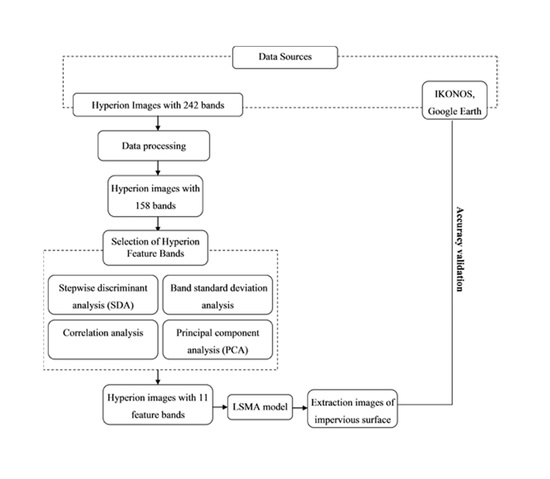Impervious Surface Information Extraction Based on Hyperspectral Remote Sensing Imagery
Abstract
:1. Introduction
2. Data Sources and Preprocessing
2.1. Data Source
2.2. Study Area
2.3. Data Processing
3. Methods and Results
3.1. Selection of Hyperion Feature Bands
3.1.1. Stepwise Discriminant Analysis (SDA)
3.1.2. Band Standard Deviation Analysis
3.1.3. Correlation Analysis of Hyperion Bands
3.1.4. Principal Component Analysis (PCA)
3.1.5. Matching of the Best Feature Bands Using Other Analysis Methods
3.2. Linear Spectral Mixture Analysis (LSMA)
3.3. Accuracy Validation
3.3.1. Extraction Accuracy Validation
3.3.2. Coverage Accuracy Verification
4. Discussion
4.1. Accuracy Evaluation
4.2. Spectral Analysis of Impervious Surface Extracted Using Hyperion Image
5. Conclusions
Acknowledgments
Author Contributions
Conflicts of Interest
References
- Gillies, R.; Box, J.; Symanzik, J.; Rodemaker, E. Effects of urbanization on the aquatic fauna of the Line Creek watershed, Atlanta—A satellite perspective. Remote Sens. Environ. 2003, 86, 411–422. [Google Scholar] [CrossRef]
- Yang, L.; Huang, C.; Homer, C.; Wylie, B.; Coan, M. An approach for mapping large-area impervious surfaces: Synergistic use of Landsat-7 ETM+ and high spatial resolution imagery. Can. J. Remote Sens. 2003, 29, 230–240. [Google Scholar] [CrossRef]
- Weng, Q. Remote sensing of impervious surfaces in the urban areas: Requirements, methods, and trends. Remote Sens. Environ. 2012, 117, 34–49. [Google Scholar] [CrossRef]
- Ji, M.; Jensen, J.R. Effectiveness of subpixel analysis in detecting and quantifying urban imperviousness from Landsat Thematic Mapper imagery. Geocarto Int. 1999, 14, 33–41. [Google Scholar] [CrossRef]
- Wu, C.; Murray, A.T. Estimating Impervious Surface Distribution by Spectral Mixture Analysis. Remote Sens. Environ. 2003, 84, 493–505. [Google Scholar] [CrossRef]
- Xu, H.Q. Analysis of impervious surface and its impact on urban heat environment using the normalized difference impervious surface index (NDISI). Photogramm. Eng. Remote Sens. 2010, 76, 557–565. [Google Scholar] [CrossRef]
- Deng, C.B.; Wu, C.S. BCI: A biophysical composition index for remote sensing of urban environments. Remote Sens. Environ. 2012, 127, 247–259. [Google Scholar] [CrossRef]
- Ma, Y.; Kuang, Y.Q.; Huang, N.S. Coupling urbanization analyses for studying urban thermal environment and its interplay with biophysical parameters based on TM/ETM+ imagery. Int. J. Appl. Earth Obs. Geoinf. 2010, 12, 110–118. [Google Scholar] [CrossRef]
- Carlson, T.N.; Arthur, S.T. The impact of land use—land cover changes due to urbanization on surface microclimate and hydrology: A satellite perspective. Glob. Planet. Chang. 2000, 25, 49–65. [Google Scholar] [CrossRef]
- Shao, Y.; Li, G.L.; Guenther, E.; Campbell, J.B. Evaluation of topographic correction on subpixel impervious cover mapping with CBERS-2B data. IEEE Geosci. Remote Sens. Lett. 2015, 12, 1675–1679. [Google Scholar] [CrossRef]
- Lu, D.S.; Hetrick, S.; Moran, E. Impervious surface mapping with Quickbird imagery. Int. J. Remote Sens. 2011, 32, 2519–2533. [Google Scholar] [CrossRef] [PubMed]
- Xu, H.Q. Rule-based impervious surface mapping using high spatial resolution imagery. Int. J. Remote Sens. 2013, 34, 27–44. [Google Scholar] [CrossRef]
- Durbha, S.S.; King, R.L.; Younan, N.H. Support vector machines regression for retrieval of leaf area index from multiangle imaging spectroradiometer. Remote Sens. Environ. 2007, 107, 348–361. [Google Scholar] [CrossRef]
- Okujeni, A.; van der Linden, S.; Hostert, P. Extending the vegetation–impervious–soil model using simulated EnMAP data and machine learning. Remote Sens. Environ. 2015, 158, 69–80. [Google Scholar] [CrossRef]
- Van de Voorde, T.; De Roeck, T.; Canters, F. A comparison of two spectral mixture modelling approaches for impervious surface mapping in urban areas. Int. J. Remote Sens. 2009, 30, 4785–4806. [Google Scholar] [CrossRef]
- Yuan, F.; Bauer, M.E. Mapping impervious surface area using high resolution imagery: A comparison of object-based and per pixel classification. In Proceedings of the American Society for Photogrammetry and Remote Sensing 2006 Annual Conference, Reno, NV, USA, 1 May 2006. [Google Scholar]
- Hu, X.F.; Weng, Q.H. Impervious surface area extraction from IKONOS imagery using an object-based fuzzy method. Geocarto Int. 2011, 26, 3–20. [Google Scholar] [CrossRef]
- Weng, Q.H.; Hu, X.F. Medium spatial resolution satellite imagery for estimating and mapping urban impervious surfaces using LSMA and ANN. IEEE Trans. Geosci. Remote Sens. 2008, 46, 2397–2406. [Google Scholar] [CrossRef]
- Pu, R.L.; Gong, P.; Michishita, R.; Sasagawa, T. Spectral mixture analysis for mapping abundance of urban surface components from the Terra/ASTER data. Remote Sens. Environ. 2008, 112, 939–954. [Google Scholar] [CrossRef]
- Ridd, M.K. Exploring a V-I-S (vegetation-impervious surface-soil) Model for Urban Ecosystem Analysis through Remote Sensing: Comparative Anatomy for Cities. Int. J. Remote Sens. 1995, 16, 2165–2185. [Google Scholar] [CrossRef]
- Wu, C. Normalized spectral mixture analysis for monitoring urban composition using ETM+ imagery. Remote Sens. Environ. 2004, 93, 480–492. [Google Scholar] [CrossRef]
- Powell, S.L.; Cohen, W.B.; Yang, Z.; Pierce, J.D.; Alberti, M. Quantification of impervious surface in the Snohomish Water Resources Inventory Area of western Washington from 1972–2006. Remote Sens. Environ. 2008, 112, 1895–1908. [Google Scholar] [CrossRef]
- Yang, F.; Matsushita, B.; Fukushima, T. A pre-screened and normalized multiple endmember spectral mixture analysis for mapping impervious surface area in Lake Kasumigaura Basin, Japan. ISPRS J. Photogramm. Remote Sens. 2010, 65, 479–490. [Google Scholar] [CrossRef]
- Lu, D.; Moran, E.; Hetrick, S. Detection of impervious surface change with multitemporal Landsat images in an urban-rural frontier. ISPRS J. Photogramm. Remote Sens. 2011, 66, 298–306. [Google Scholar] [CrossRef] [PubMed]
- Zhou, C.; Xu, H. A Spectral Mixture Analysis and Mapping of Impervious Surfaces in Built-up Land of Fuzhou City. J. Image Graph. 2007, 12, 875–881. [Google Scholar]
- Zhao, X.; Qiu, Q. A Comparative Study of Four Spectral Mixture Analysis Methods for Land Surface Composition in a Hilly Coastal City. Remote Sens. Technol. Appl. 2009, 24, 737–742. [Google Scholar]
- Li, B.; Huang, J.; Wu, C. Estimating Urban Impervious Surface Based on Thermal Infrared Remote Sensing Data and a Spectral Mixture Analysis Model. J. Nat. Res. 2012, 27, 1590–1600. [Google Scholar]
- SAS Institute. SAS/STAT(R) 9.2 User's Guide, Second Edition; SAS Institute: Cary, NC, USA, 2008. [Google Scholar]
- Xu, H.Q. Modification of Normalized Difference Water Index (NDWI) to Enhance Open Water Features in Remotely Sensed Imagery. Int. J. Remote Sens. 2006, 27, 3025–3033. [Google Scholar] [CrossRef]
- Boardman, J.W.; Kruse, F.A.; Green, R.O. Mapping target signatures via partial unmixing of AVIRIS data. In Proceedings of the Fifth JPL Airborne Earth Science Workshop, Pasadena, CA, USA, 23–26 January 1995. [Google Scholar]
- Xian, G.; Crane, M. An analysis of urban thermal characteristics and associated land cover in Tampa Bay and Las Vegas using Landsat satellite data. Remote Sens. Environ. 2006, 104, 147–156. [Google Scholar] [CrossRef]
- Tang, F.; Xu, H.Q. Comparison of performances in retrieving impervious surface between Hyperspectral (Hyperion) and multispectral (TM/ETM+) images. Spectrosc. Spectr. Anal. 2014, 34, 1075–1080. [Google Scholar]
- Weng, Q.; Hu, X.; Lu, D. Extracting impervious surfaces from medium spatial resolution multispectral and hyperspectral imagery: A comparison. Int. J. Remote Sens. 2008, 29, 3209–3232. [Google Scholar] [CrossRef]
- Chang, C.I.; Chiang, S.S.; Smith, J.A.; Ginsberg, I.W. Linear spectral random mixture analysis for hyperspectral imagery. IEEE Trans. Geosci. Remote Sens. 2002, 40, 375–392. [Google Scholar] [CrossRef]
- Nielsen, A.A. Spectral Mixture Analysis: Linear and Semi-parametric Full and Iterated Partial Unmixing in Multi- and Hyperspectral Image Data. Int. J. Comput. Vis. 2001, 42, 17–37. [Google Scholar] [CrossRef]
- Dobigeon, N.; Altmann, Y.; Brun, N.; Moussaoui, S. Linear and nonlinear unmixing in Hyperspectral imaging (Chapter 6). Data Handl. Sci. Technol. 2016, 30, 185–224. [Google Scholar]
- Thenkabail, P.S.; Enclona, E.A.; Ashton, M.S.; Van Der Meer, B. Accuracy assessments of hyperspectral waveband performance for vegetation analysis applications. Remote Sens. Environ. 2004, 91, 354–376. [Google Scholar] [CrossRef]
- Wu, D.H.; Fan, W.J.; Cui, Y.K.; Yan, B.Y.; Xu, X.R. Review of monitoring soil water content using hyperspectral remote sensing. Spectrosc. Spectr. Anal. 2010, 30, 3067–3071. [Google Scholar]
- Guerschman, J.P.; Hill, M.J.; Renzullo, L.J.; Barrett, D.J.; Marks, A.S.; Botha, E.J. Estimating fractional cover of photosynthetic vegetation, non-photosynthetic vegetation and bare soil in the Australian tropical savanna region upscaling the EO-1 Hyperion and MODIS sensors. Remote Sens. Environ. 2009, 113, 928–945. [Google Scholar] [CrossRef]
- Xu, H.Q.; Wang, M.Y. Remote sensing-based retrieval of ground impervious surfaces. J. Remote Sens. 2016, 20, 1270–1289. [Google Scholar]
- Parent, J.R.; Volin, J.C.; Civco, D.L. A fully-automated approach to land cover mapping with airborne LiDAR and high resolution multispectral imagery in a forested suburban landscape. ISPRS J. Photogramm. Remote Sens. 2015, 104, 18–29. [Google Scholar] [CrossRef]
- Singh, K.K.; Vogler, J.B.; Shoemaker, D.A.; Meentemeyer, R.K. LiDAR-Landsat data fusion for large-area assessment of urban land cover: Balancing spatial resolution, data volume and mapping accuracy. ISPRS J. Photogramm. Remote Sens. 2012, 74, 110–121. [Google Scholar] [CrossRef]
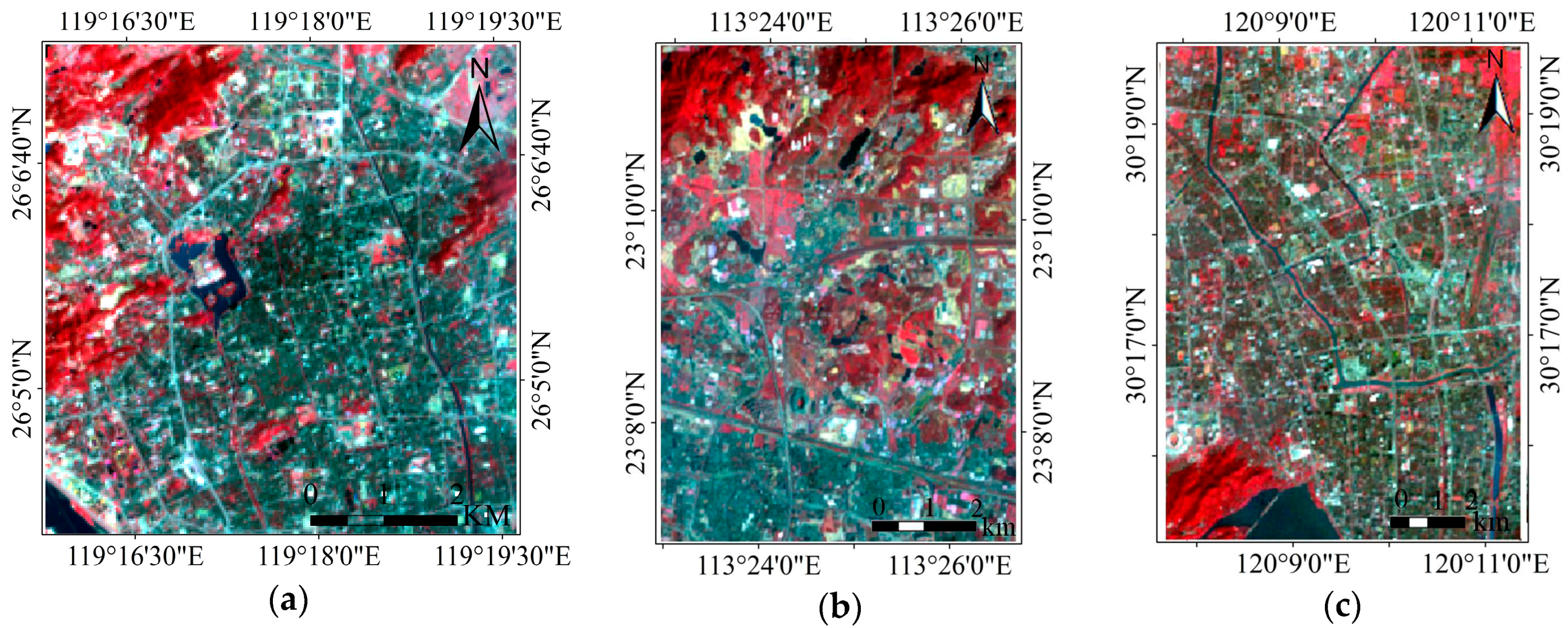
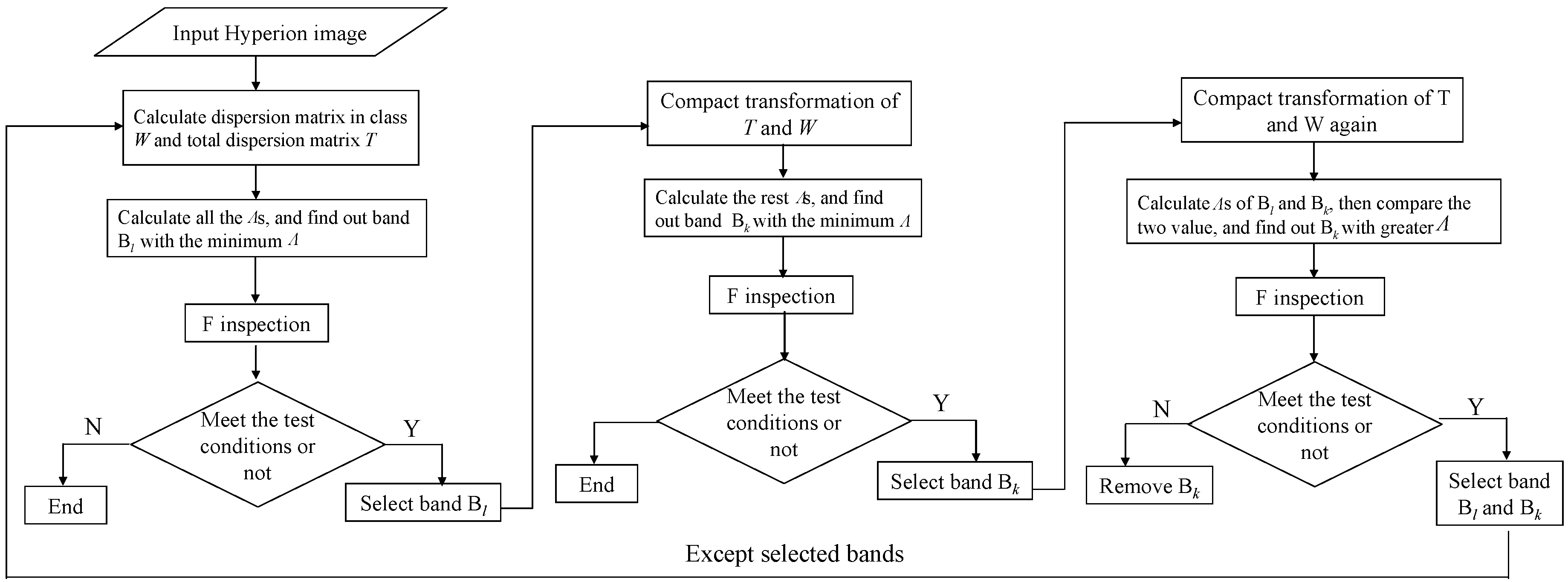
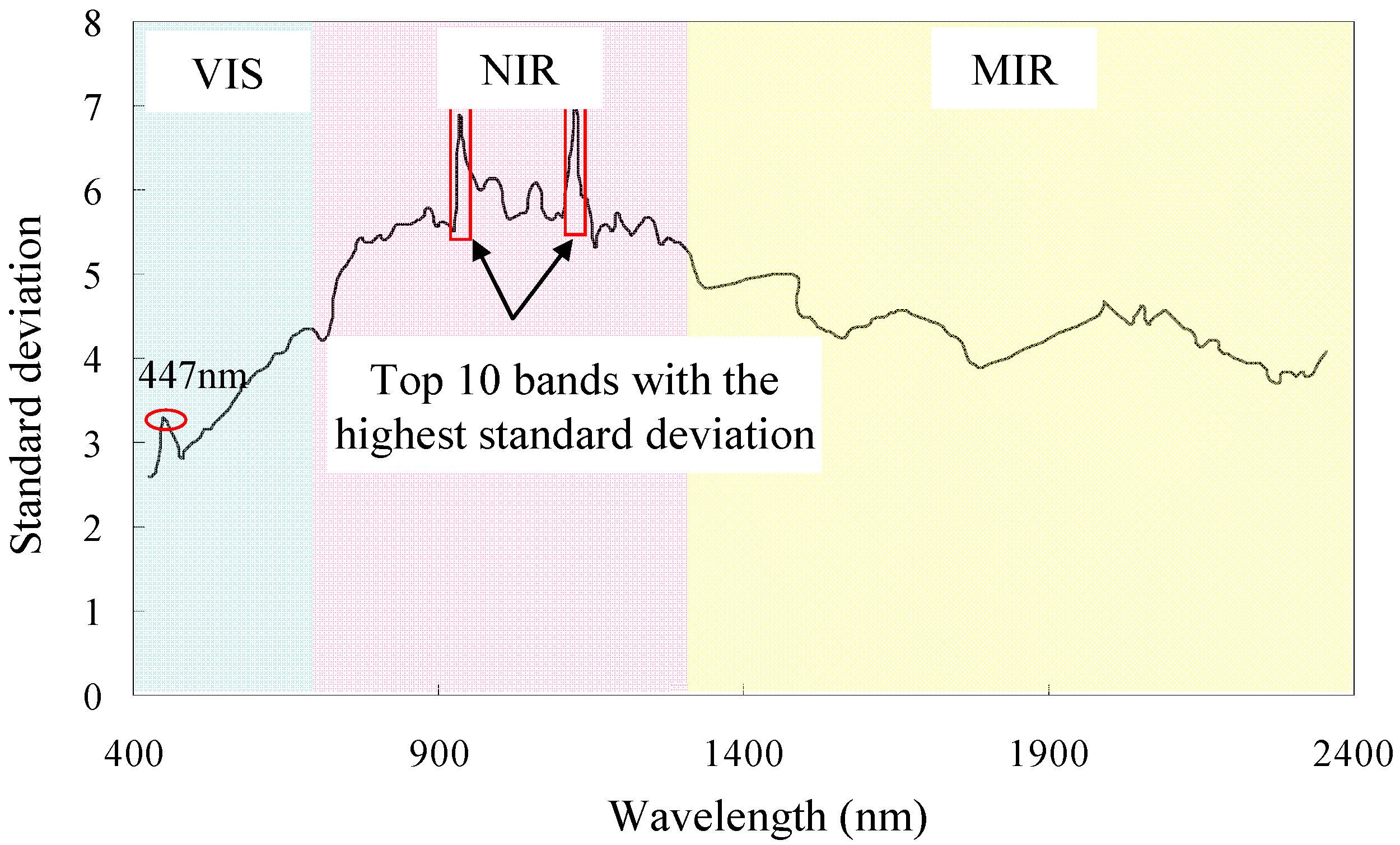
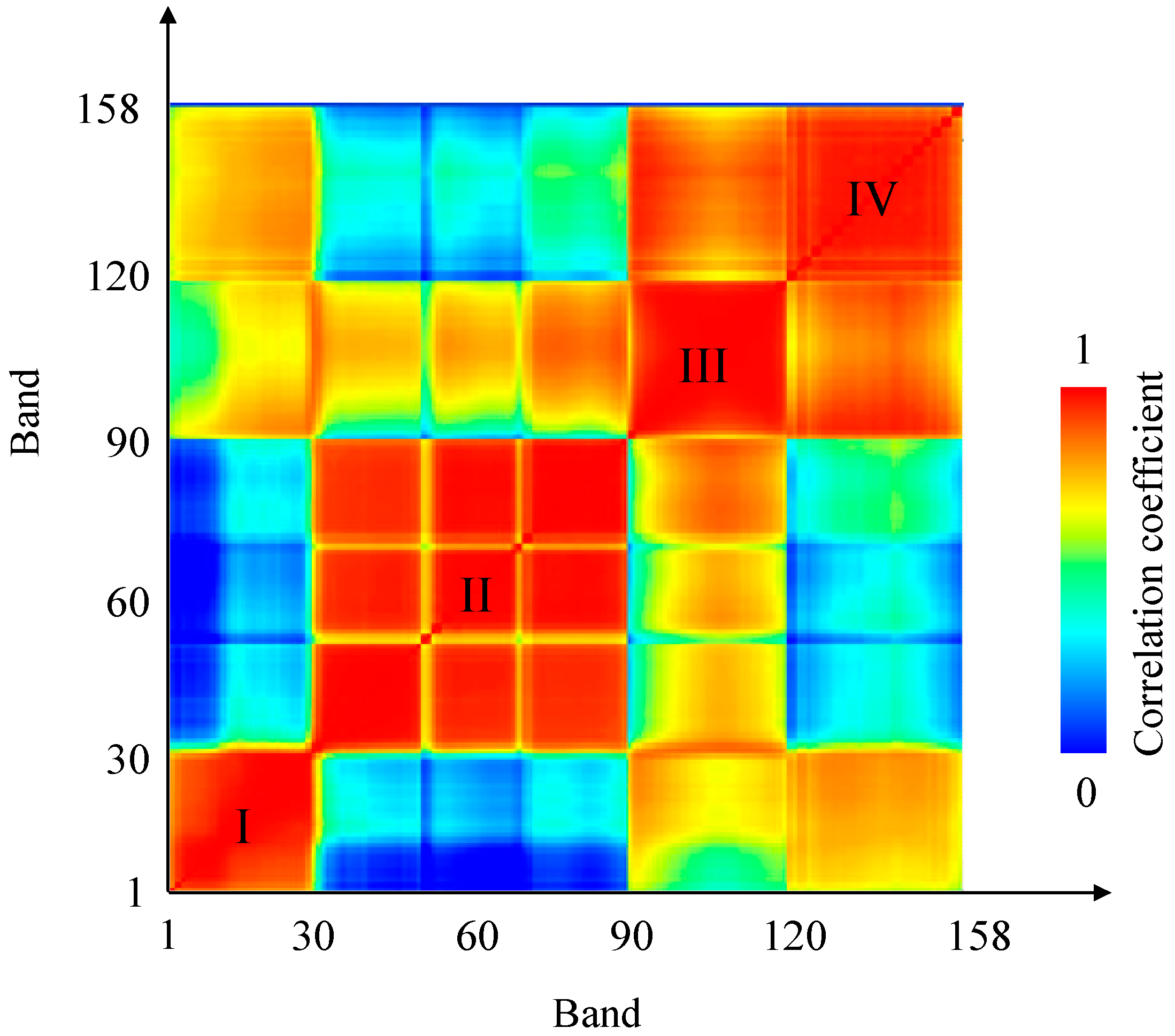
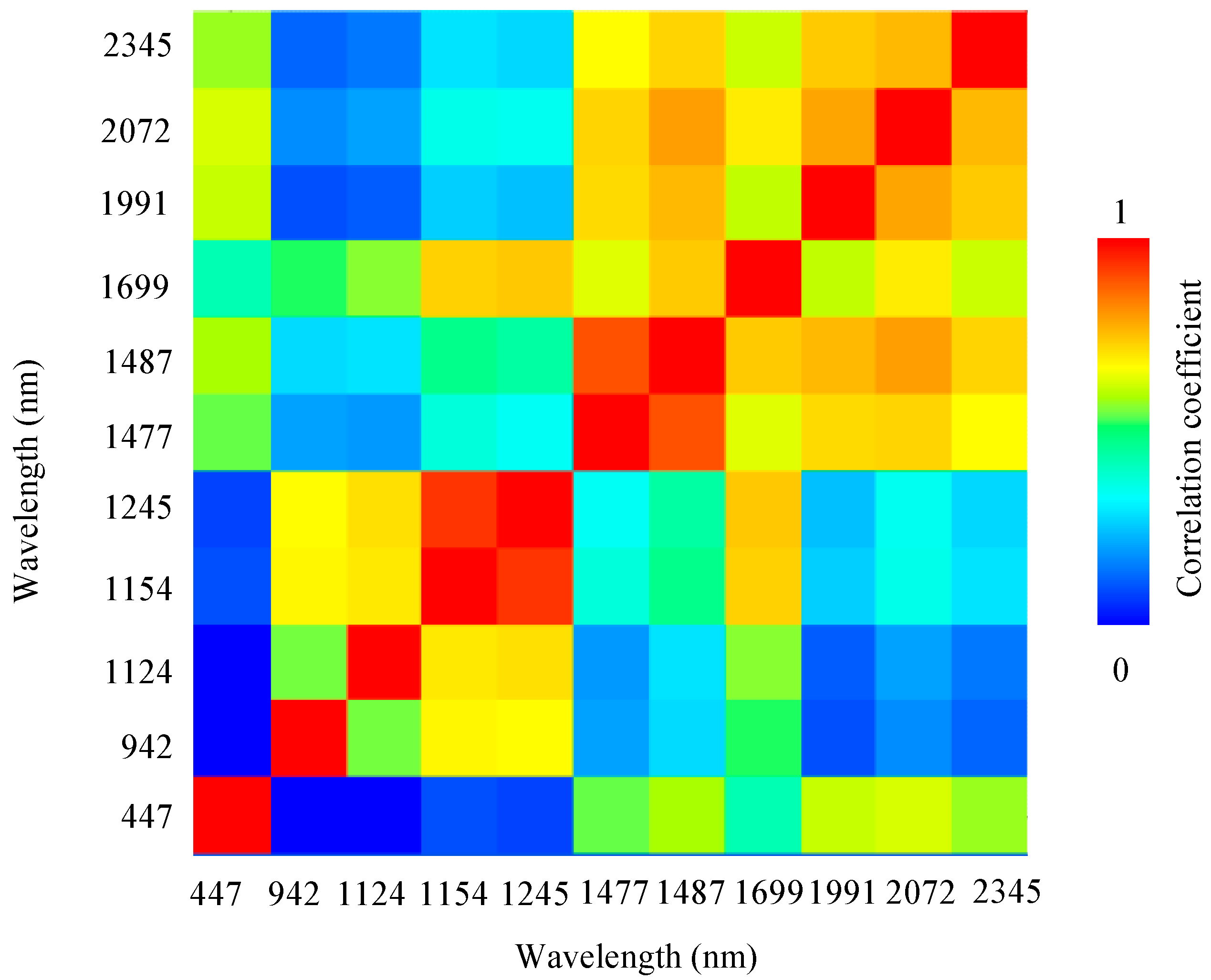
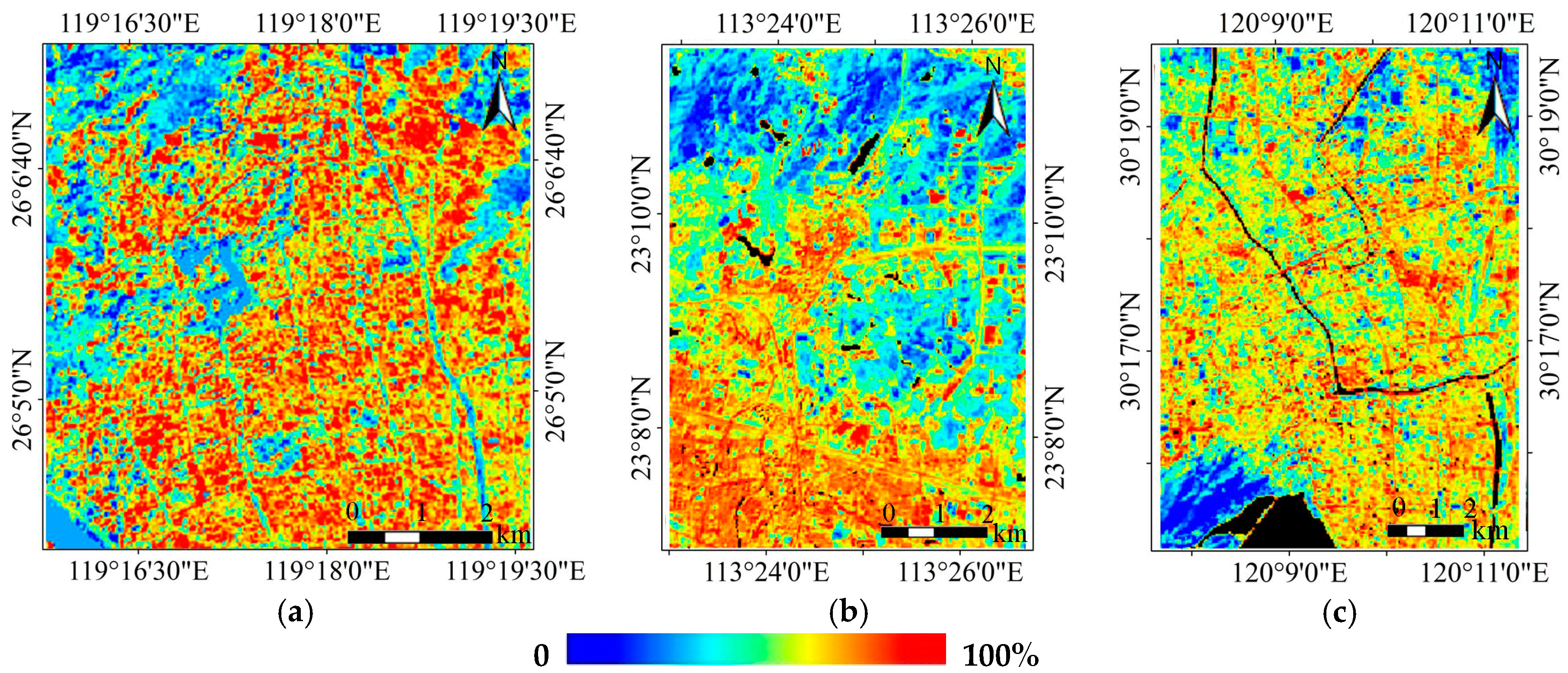
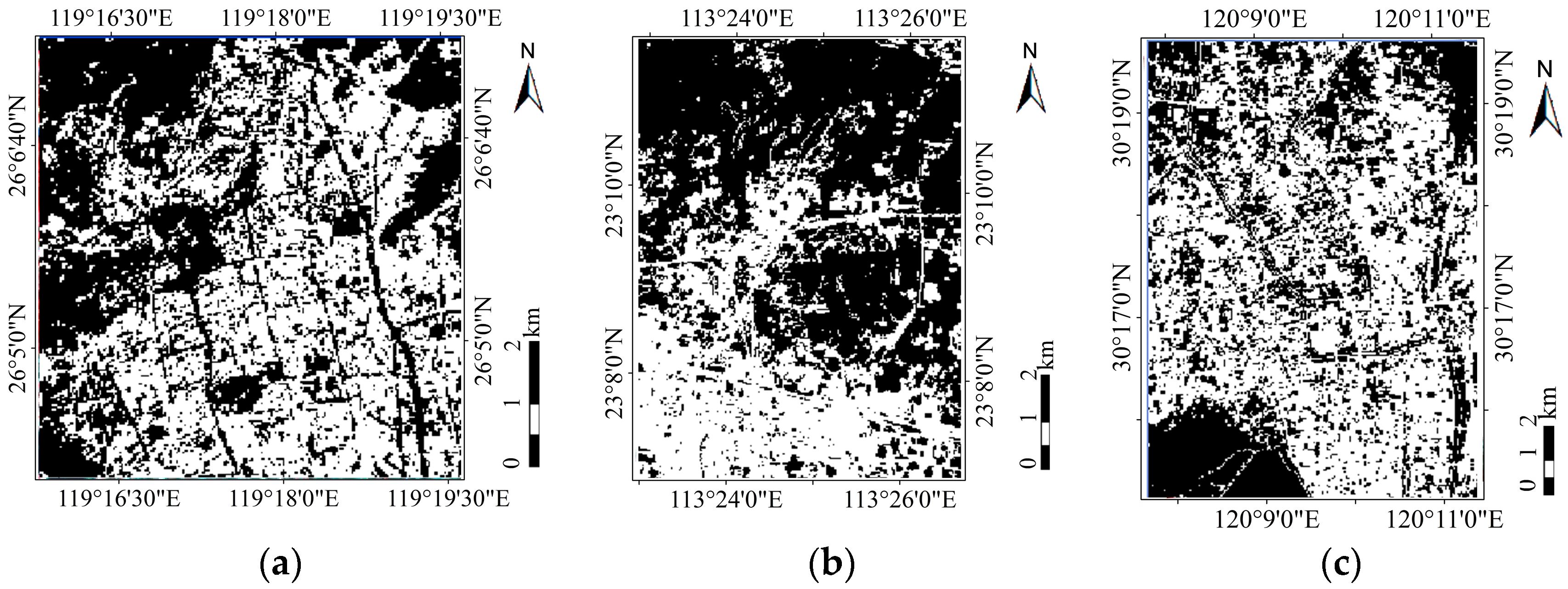

| Sensors | Area | Date | Number of Bands | Spatial Resolution | Use |
|---|---|---|---|---|---|
| Hyperion | Fuzhou | 26 March 2003 | 242 | 30 m | Feature bands selection |
| Hangzhou | 2 November 2002 | 242 | 30 m | Model validation | |
| Guangzhou | 5 March 2008 | 242 | 30 m | ||
| IKONOS | Fuzhou | 22 June 2003 | 4 | 4 m | Accuracy validation |
| Google Earth | Hangzhou | 26 September 2002 | 3 | 4 m | |
| Guangzhou | 26 July 2008 | 3 | 4 m |
| Block I | Block II | Block III | Block IV | |
|---|---|---|---|---|
| Block I | 0.956 | |||
| Block II | 0.425 | 0.956 | ||
| Block III | 0.737 | 0.778 | 0.974 | |
| Block IV | 0.816 | 0.520 | 0.885 | 0.957 |
| PCA Bands | Wavelength (nm) | Dominant Bands |
|---|---|---|
| PC1 | 983, 993, 1124, 1003, 972, 1053, 1114, 962, 1063, 1194, 1245, 952, 1144, 1174, 1205, 1235, 884, 942, 1154, 1225 | NIR |
| PC2 | 1981, 1991, 2042, 2052, 2032, 2072, 2082, 2092, 2062, 681, 671, 1477, 2102, 691, 660, 2113, 2123, 2133, 650, 2345 | MIR2, Red |
| PC3 | 1991, 1981, 2042, 2052, 2032, 2193, 2203, 2355, 2183, 2345, 2062, 2072, 2213, 2224, 2082, 2092, 2173, 2234, 2163, 2314 | MIR2 |
| PC4 | 932, 942, 952, 1477, 962, 1981, 1487, 1991, 447, 457, 487, 467, 498, 508, 477, 518, 436, 2345, 528, 2072 | NIR, MIR1, Blue, Green, MIR2 |
| PC5 | 1124, 1114, 681, 671, 660, 691, 650, 1134, 630, 640, 1144, 620, 610, 599, 589, 579, 701, 1194, 1245, 1205 | Green, Red, NIR |
| Ground Types | Area | Fuzhou | Guangzhou | Hangzhou |
|---|---|---|---|---|
| Impervious surface | Overall accuracy | 90.33% | 88.33% | 88.00% |
| Kappa | 0.801 | 0.761 | 0.753 | |
| Soil | Overall accuracy | 89.20% | 88.27% | 85.11% |
| Kappa | 0.782 | 0.757 | 0.721 | |
| Vegetation | Overall accuracy | 90.80% | 86.65% | 85.37% |
| Kappa | 0.807 | 0.736 | 0.725 |
| Area | Ground Types | Image Pairs | Average | RMSE | SE | R2 |
|---|---|---|---|---|---|---|
| Fuzhou | Impervious surface | Hyperion | 0.645 | 0.099 | −0.024 | 0.800 |
| IKONOS | 0.668 | / | / | / | ||
| Vegetation | Hyperion | 0.398 | 0.006 | 0.021 | 0.845 | |
| IKONOS | 0.377 | / | / | / | ||
| Soil | Hyperion | 0.107 | 0.003 | 0.011 | 0.890 | |
| IKONOS | 0.096 | / | / | / | ||
| Guangzhou | Impervious surface | Hyperion | 0.579 | 0.077 | −0.016 | 0.881 |
| Google Earth | 0.595 | / | / | / | ||
| Vegetation | Hyperion | 0.434 | 0.086 | 0.013 | 0.816 | |
| Google Earth | 0.421 | / | / | / | ||
| Soil | Hyperion | 0.187 | 0.005 | 0.008 | 0.853 | |
| Google Earth | 0.179 | / | / | / | ||
| Hangzhou | Impervious surface | Hyperion | 0.662 | 0.089 | −0.034 | 0.894 |
| Google Earth | 0.696 | / | / | / | ||
| Vegetation | Hyperion | 0.375 | 0.106 | 0.022 | 0.769 | |
| Google Earth | 0.353 | / | / | / | ||
| Soil | Hyperion | 0.086 | 0.098 | 0.013 | 0.802 | |
| Google Earth | 0.073 | / | / | / |
© 2017 by the authors. Licensee MDPI, Basel, Switzerland. This article is an open access article distributed under the terms and conditions of the Creative Commons Attribution (CC BY) license (http://creativecommons.org/licenses/by/4.0/).
Share and Cite
Tang, F.; Xu, H. Impervious Surface Information Extraction Based on Hyperspectral Remote Sensing Imagery. Remote Sens. 2017, 9, 550. https://doi.org/10.3390/rs9060550
Tang F, Xu H. Impervious Surface Information Extraction Based on Hyperspectral Remote Sensing Imagery. Remote Sensing. 2017; 9(6):550. https://doi.org/10.3390/rs9060550
Chicago/Turabian StyleTang, Fei, and Hanqiu Xu. 2017. "Impervious Surface Information Extraction Based on Hyperspectral Remote Sensing Imagery" Remote Sensing 9, no. 6: 550. https://doi.org/10.3390/rs9060550





